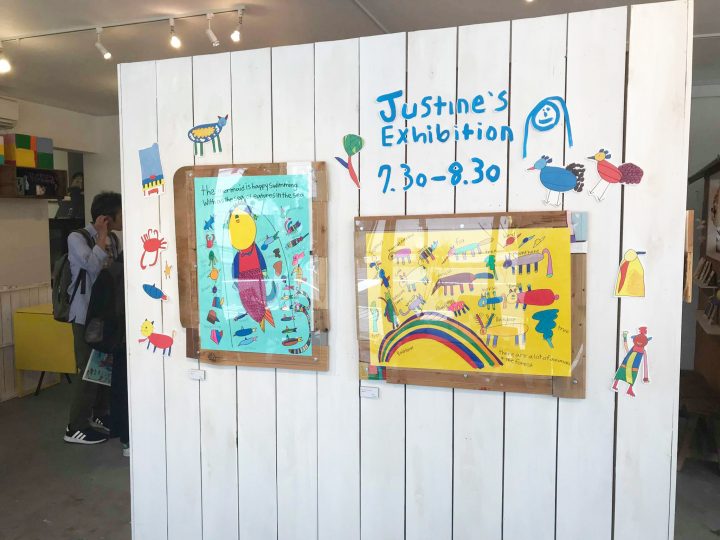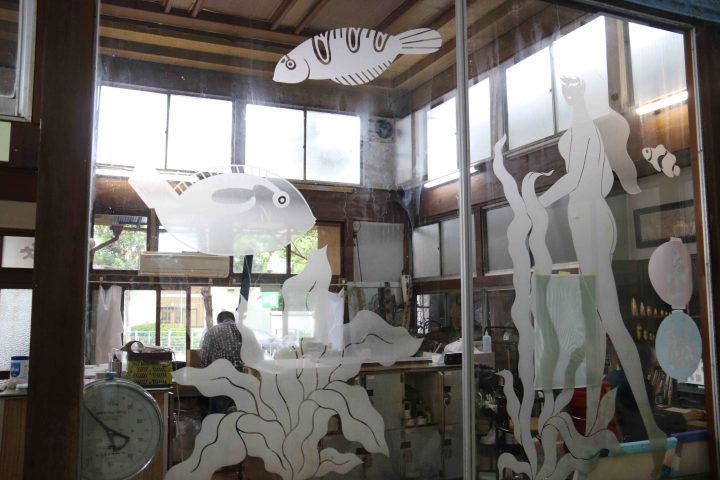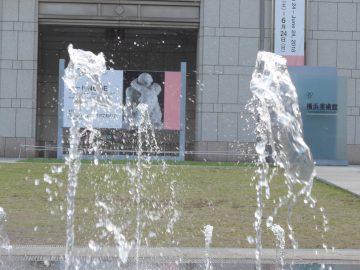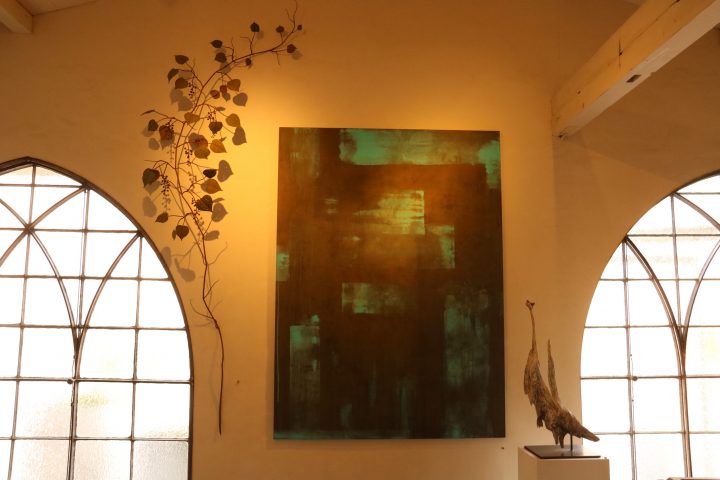Interview with Protruding Parts | I want to be more free to interact with society

Have you heard of "Hamidashi Parts," a group of notable artists based in Kamakura?
All of the members of the group, who have already completed three independent projects in Kamakura and continue to pursue free expression from painting to video, are elementary school students*. The members of "Hamidashi Parts" are about to become junior high school students and reach a turning point. Magcal invited members Shinya and Mondo, as well as their supporter and mentor as an artist, Tatsushi Takizawa, to join them and talk about "the past and future of the hamidashi" and the "expression" they see.
*=Interview conducted in February 2015
2015.4.1 interview&text: Masamasa Nishino photo: Eri Nishiyama(Portrait)
When something sticks out, it sticks out
Shinya = S Mondo = M Takizawa = T
—Thank you for joining us today. So, first of all, what was the trigger for starting "Hidashi Parts"?
S : It all started with Mondo next to me and Keitaro, another member who is not with us today. They had previously questioned the obvious rule that "we march at sports days." Generally, people do as they're told without questioning it, but they thought that was strange. They started making works with the idea that they wanted to be more free in their interactions with society, and gradually more people who sympathized with them gathered, and the number of members grew to 12 in total.
—Why did you think that creating art would be a way to engage with society?
M: At first, I didn't create works with the intention of making them as "artworks" just as a hobby. But as I exhibited my creations and experienced interacting with various people, I realized that I could connect with society through my work, and from then on I started consciously creating "artworks."
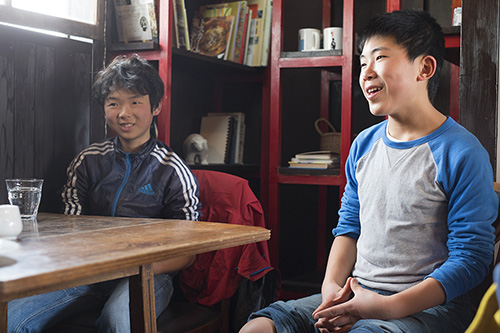
--These days you hold exhibitions and so on, and I think that Hidashi Kata fits into the category of an "artist group," but was that not your mindset at all when you first formed?
S: I think that both I and everyone else was greatly influenced by Mr. Takamatsu (note 1), who was our art teacher at the time. In my case, when I took the class "Drawing the Sun" that he taught me, the act of "drawing a round sun, drawing a circle, and painting it red" was similar to school, or rather, it was similar to everyone just doing exactly what someone told them to do. I always had doubts about it and drew pictures in the art room, but Mondo and Keitaro also started drawing pictures with me, and I started to think that thinking with doubts, expressing with your body, and making art by drawing it could be a way to get involved with society... Hmm, a group of artists is fine!
Everyone: lol
(Note 1) Tomoyuki Takamatsu
Born in Kyoto in 1976. Graduated from the Department of Fine Arts, Faculty of Education, Yokohama National University. Alongside teaching at an elementary school, he has worked as a planner for documentary films about children set at the Museum of Modern Art, Kanagawa Prefecture and the Mugonkan Memorial Museum for Art Students who died in war, as well as the art project "Kamakura Nanka Nare" set at an active elementary school. In 2014, he launched the "Kamakura Art Workshop" to support creative activities using protruding parts.
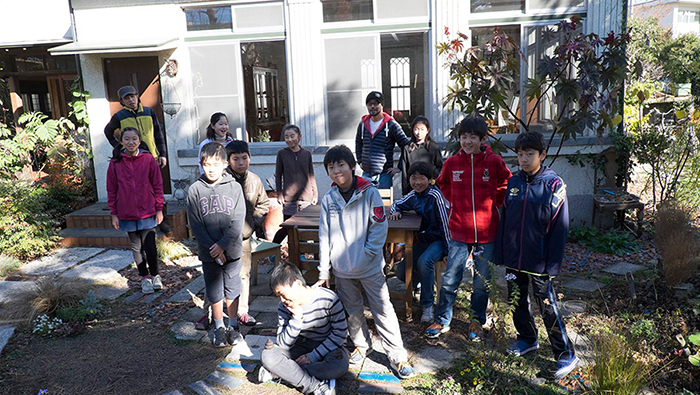
Photo: Group photo of protruding parts / photo by Junichiro Suga
—It seems like that class was the trigger for you, Shinya, but did your teacher teach you to "question" such things?
S: Takamatsu sensei didn't directly teach us in words, but rather said things like "It's okay to doubt," or "The sun can be round and red, but is that the real sun?" He wasn't assertive in his words, but more like he was asking "Is it really like that?" The current members of Hamidashi responded to that, and of course there were other kids who responded too, but "Hamidashi Parts" was started by people who had a strong desire to "get involved in society through expression."
- By the way, how did the group's memorable name "Hamidashi Buhin" come about?
S: We didn't just do what the teacher tells us to do like a part on a rail, but we wanted to go beyond that and break free, so we called it an "extra-rail part."
My first trip / Facing myself
- I would also like to ask Mr. Takizawa, who was also with us once. Mr. Takizawa has always supported Hamidashi's activities by participating in projects with them and teaching them about video and other technical matters. This interview was made possible thanks to Mr. Takizawa, but could you tell us how you met them?
T: A long time ago, their elementary school held an event called " Kamakura Something Nare," which opened the school for three days under the theme "Anyone can express themselves at school." I participated in the event as an invited artist, and that's when I first met them. At "Kamakura Something Nare ," teachers also expressed themselves, and students also made their own works and did installations, so I was surprised that the word "installation" had even become widespread in the first place (laughs). In the end, I got in touch with them through the exhibition, and as I continued to interact with them and go to their exhibitions afterwards, I thought, "I want to do something together," and at that time, one of the Midashi members asked me if he wanted to go on a trip, so I said, "Let's do it together," and we've been friends ever since.
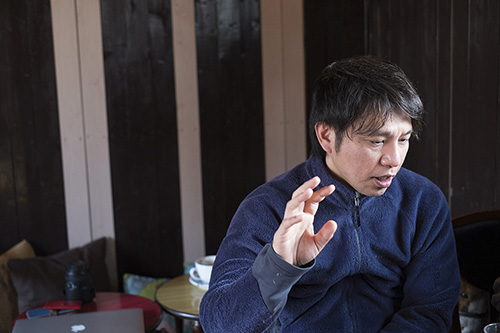
-I'm very curious about the interesting aspects of the elementary school you all go to, such as inviting artists and opening the school to the public. By the way, what did you mean when you said you traveled together?
T: At that time, I was invited to an art project being held in Aizu, Fukushima, so we went to Fukushima together, but only those who wanted to go. At the time, there was the Fukushima nuclear power plant issue, so some kids were able to go and some couldn't.
- Did Shinya and Mondo participate?
M: We didn't participate.
T: Only three people were able to participate in Aizu, and some children wanted to participate but couldn't. During the camp, we decided to think about the complex issue of "nuclear power" together, and instead of going to Fukushima, they (Shinya and Mondo) worked at the Kanagawa Prefectural Museum of Modern Art in Hayama.
—Although Aizu and Kamakura were in different locations, the same issues were discussed. How was the content of those discussions presented?
T: The exhibition they held in Kamakura last year, titled " Mountains and the Sea ," was the result of their efforts. The purpose of the camp was not just to discuss nuclear power, but also to explore what each of them wanted to do in terms of expression, so the children who went to Fukushima naturally included content about nuclear power in their works, while the children who participated in Kamakura were purely interested in their own paintings and deepening their own expressions.

Left: Keitaro + 4th grade class 1 "Garbage Graduation Ceremony" / Kamakura Nantanare 2012 | Right: Exterior parts "Mountain and Plum" exhibition view / 2014
-I see. The title of the exhibition, "Mountains and the Sea," means that the mountains are Fukushima and the sea is Kamakura. We've just talked about the exhibition, but I heard that it was created entirely by members of the Miscellaneous Parts group. Could you tell us about the path that led to the exhibition?
S: First of all, when it was decided that " Tradition-Free Variety Show " would be Hamidashi's first exhibition, I was on the train with a painting I had been working on, planning to work on it at home, when the manager of a local toy store spoke to me. I gave him a flyer saying "This is what we do," and he came to the exhibition. After that, when we were wondering where to hold "Mountains and Sea," we asked the manager for advice, and he introduced us to this location, so we negotiated from there.
--That's a great encounter that came about through your activities! I heard that you raised the funds for the flyers and exhibitions all by yourself.
M: At a different time from the training camp, we went to Kitakata, Fukushima to participate in a talk presentation about our activities in the mountains and the sea. At the time, we sold a CD of a strange song by the unit Keitaro and I, called " Umeboshi Pan ," to some drunk old men, and it sold quite well. That's how we were able to secure the funds to print flyers (laughs).
Link video: Umeboshi Pan's live performance in Kitakata
- It's really self-reliant and wonderful that you two are raising funds for the exhibition by selling the things you made. By the way, what kind of works did you two exhibit at "Mountains and Sea"?

Left: A part of the sun drawn by Shinya in Takamatsu sensei's class | Right: Shinya's work "Mountains and the Sea" exhibited in 2014
S: I participated in a training camp held at the Hayama Museum of Art as the "sea" of "Mountains and Sea", and I've never really liked mixed colors, or rather, I thought about why I like those colors during the training camp, and I found an answer. I hate the time it takes to decide on cleaning duty or other unpopular duties at school... so I end up doing it myself, but I don't feel very good about it, or if I express that feeling in color, it seems like a muddy color, or it overlaps with that feeling, so I think I like unmixed colors. I feel like I'm only using reason at school, and I don't really do what I want to do. So I just wanted to draw the picture as I wanted without thinking about anything, and the touch is strong... it's a bit difficult, but that's how the picture turned out.
M: I create works about poop. The reason I chose poop is because I used to jokingly repeat "poop poop" at school. But everyone criticized me for that. So I started thinking about why I had to be told it was "gross and dirty," and this time I tried to express various things about poop.
--That's very interesting (laughs). What method did you use to express "poop" in your work?
M: Firstly, for my second exhibition, “ I’ve given up on symmetry ,” held at Asaba Art Square, I made a 34cm diameter golden poop as an extra part. But it ended up being just a joke, and although many people said it was interesting, I felt like I hadn’t explored the meaning of poop at all.

Left: Oketu Field (part) from Mondo's "Mountains and Sea" exhibition / 2014 | Right: Mondo's "Mountains and Sea" exhibition / 2014
—At the time, you were so focused on how interesting it was that you weren't able to fully explore the essence of the work.
M: That's right. So I thought about what to do with "Mountains and Sea" this time, and I ended up expressing it by mixing in photos of poop and poetry, but for me, it still wasn't quite what I wanted... I personally feel like it's still not complete.
Future works/future overhangs
-By the way, I saw some photos of the exhibition scene earlier, and I got the impression that you were quite particular about the technical aspects. Is that a completely original technique for both of you? If there are any artists who influenced you, please tell us.
S: This is also the case with the painting I did this time, but I don't use mixed colors very often, so I like Taro Okamoto's work. Okamoto uses mixed colors, but his colors are not so muddy, and there is movement in his use of colors. I think the reason I don't mix colors much now is because of Taro Okamoto's influence, and I feel like I can sense the "talking" that I learned from my teachers at school, so I may have been influenced in that respect as well.
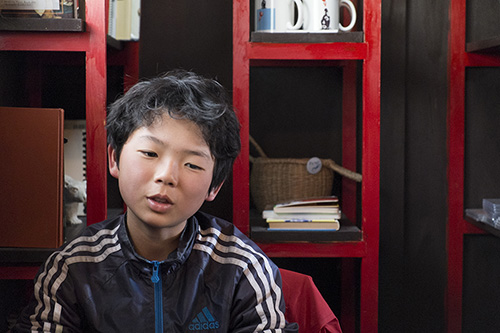
M: I haven't been influenced by anyone in my work up until now, but recently I've been paying attention to Masaaki Izawa , who is researching fungi and other things. Izawa started intentionally defecating outdoors after he realized that the advent of flush toilets had removed feces from the traditional cycle of returning to nature. He apparently only used a toilet once around 2012, but he's been obsessed with defecating outdoors ever since (laughs). (Izawa has defecated outdoors over 13,000 times so far, and his basic rule is to wipe your bottom with a leaf.) Izawa is acquainted with the owner of the cafe where I previously exhibited, and since Izawa is going to exhibit there soon, I'm thinking of meeting him in person and talking to him about various things. Thinking about it like that, his previous works may have been a preparation stage for this.
-So you'll be showing materials from the works you've created so far and revisiting your own form of expression.
M: Well, I'm not sure yet if I'll be able to talk to him directly, but I'll bring some materials with me!
T: In his work, he interviews various people about poop, and the people who answer are not just half-entertained, but some who think about it quite seriously, and they give him all kinds of information, like, "There are people like this too." By the way, Izawa-san participated as a guest in the exhibition " Sumo Alone " organized by Hideaki Shibata of Yodogawa Technique, and I told him about it because I really wanted him to meet Mondo-kun.
--I'm sure it will be a meaningful encounter for you as well. By the way, was the interview method your own original idea?
M: I came up with the interview on my own. I've screened the interviews I recorded in other works, but next time there will be an event called the "Unko Film Festival" that collects films about poop, so I'm thinking of submitting to that as well.
— The world is so big. So your next step is to make a movie.
M: For me it's the movie, but originally it was about the activities of the "extra parts" team...
I was just about to ask you about your future plans as a team.
M: We had a meeting with all the members recently, and we talked about how we've had two or three exhibitions so far, and it's starting to feel like we have to do it. Keitaro and I did a live performance at an exhibition as "Umeboshi Pan," but to be honest, we didn't really want to do it. We talked about how it was starting to get more and more difficult to do as a group, and we decided that from now on, we'll just do what we want to do, not just be part of something else.
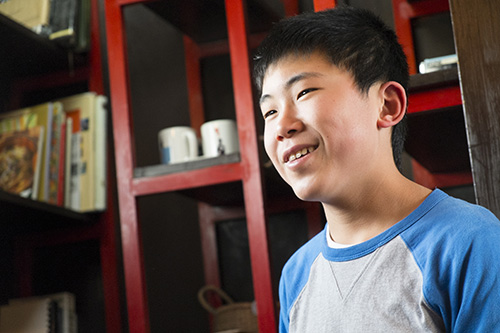
--So, rather than disbanding, you're just taking a hiatus and each member will focus on their own activities?
S: That's right. We're not going to disband, but if each of us naturally wants to do something, we'll just keep doing it. From now on, we'll be in junior high school and we might not even have time to create works.
M: But even if we don't have an exhibition, we plan to ask a photographer to give a photography class so that each member can find what they want to do, and we also plan to invite members to go to an exhibition.
—The idea behind starting this was to break away from established rules, but you felt a sense of crisis that you were the ones creating the rules yourself.
M: Yes. However, I do feel that it is inevitable that such restrictions arise when interacting with society, but I also feel that I would like to continue doing the things I want to do.
Does society need art?
-We've just heard about the direction of your future activities, but what do you think is the best thing about creating works or working in a group up until now?
S: At school, I was always thinking about how to get along with the people around me, but as I was making my work, I started to dislike that. In that respect, I think it was good that I did the protruding parts because I could concentrate on the work without thinking about those things.
M: I guess it saved me, but when I talked about poop at school, no one would understand, and I'd always been lonely on that topic. But when I went outside and talked to different people through the exhibition, some people agreed with me and said, "I think so too," so in that sense it saved me, and I was able to confirm that there are all kinds of people in the world, and that there are people who understand, so in that respect it was very good.
—Thank you. And this is a question I personally wanted to ask both of you: do you think art is necessary for society?
S: It depends on the person, but it's easy to just do what you're told and determined to do, like in school, but I feel like that doesn't produce much original work. I don't know if it's art, but... when I'm in a situation where I'm going to draw a picture, I really like the act of thinking about techniques and colors, and I think art is also necessary in finding each person's individuality.
M: Even if I shout "poop" in the world, most people won't understand what I mean. But there's art... let's say there's a "picture of poop." Then it can spark conversations with people like, "What does this mean? Why poop?" I think the interesting thing about art is that it allows you to interact with people in ways that wouldn't happen through normal conversation.
-But in recent education, the time allotted for arts and crafts education has tended to be reduced compared to the past. In that respect, is there anything you two would like to see in terms of art education?
S: I would like to be allowed to use tools more freely in art classes. In the kindergarten I went to, they let me use hammers, saws, and anything else I wanted, but I was responsible for it. But when I started elementary school, I was told to make things with just the tape and scissors I had. I think making things under limited conditions is a learning experience, but I would like to be allowed to do more things with a variety of tools.
M: I think that we should do other things, not just art. I think it would be good if there were elements of art in other subjects like Japanese and math. For example, in third grade, we had a class called "Writer's Time" where we simply wrote our own stories, which was really interesting, and in fourth grade science, we discussed what we wanted to investigate, came up with an experiment method from there, and if it didn't work, we thought about why it failed. It was really interesting to investigate the questions that arose through the experiment. In that way, I think that if there were more classes where students could create things themselves, art would not be necessary.
— Finally, please tell us your future aspirations.
S: As we discussed with everyone at Hamidashi, I myself would like to produce works if there are any projects I want to participate in in the future. However, when I think about junior high school, I feel like I need to study hard in order to live freely in the future, and I'm worried that if I only study, I won't be able to do the activities I've been doing up until now.
M: For me it's poop for a while.
Everyone: lol
M: For the time being, I would like to continue creating works on the theme of "poop" until I am satisfied with them (laughs).
—I see (laughs). Although you both have different ways of expressing yourself and thinking, I hope you will continue your work in the future. Today I was able to hear from a perspective that I hadn't even noticed before, and it was very informative.
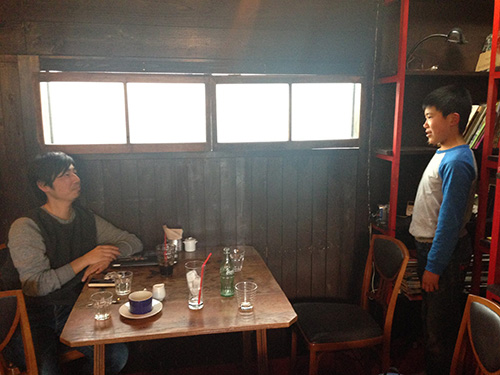
*The author was also interviewed about poop in detail.
